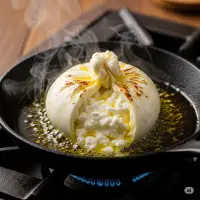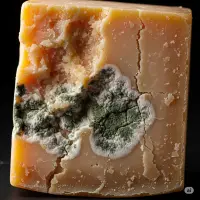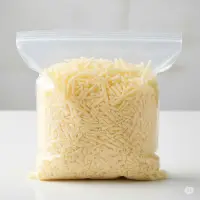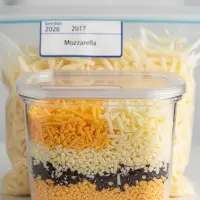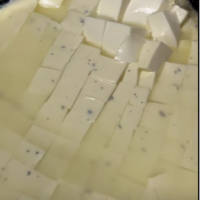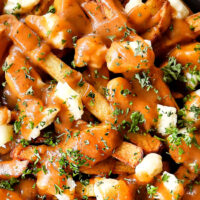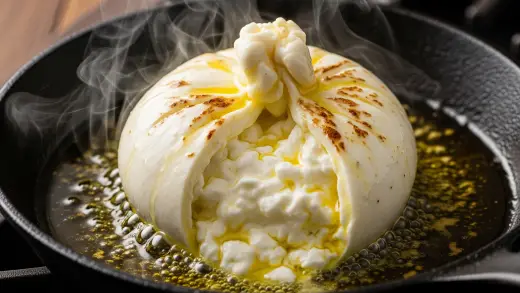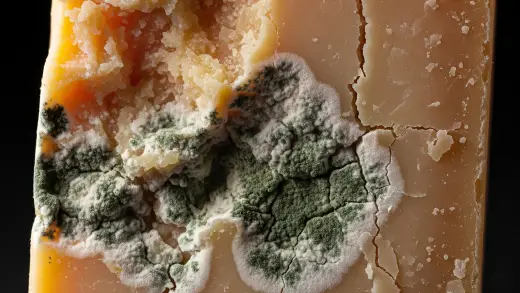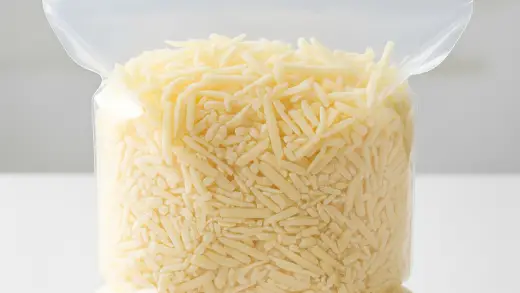No, you cannot eat the brine on brie cheese because brie cheese is not typically stored or sold in brine.
Brie cheese is a soft-ripened cheese with a bloomy rind. The rind is a result of molds and bacteria that are part of the cheesemaking process. This rind is edible and contributes to the flavor and texture of the cheese.
Ever stared at a wedge of Brie, that lovely, soft cheese with the snowy white edge, and wondered, “Can I actually eat that part?” You’re not alone! Brie is a super popular cheese known for its smooth, melty inside and that delicate, downy covering. But what about that rind?
Well, here’s the scoop: generally, yes! That white rind on your Brie is totally safe and even good to eat. Think of it like the crust on a yummy loaf of bread – it’s part of the whole experience.
This blog post will dive into why that rind is there in the first place, what it tastes like (it can change!), and why most cheese lovers happily munch it down.
We’ll also touch on the rare times you might want to skip it. So, get ready to learn all about the wonderful world of Brie rind.

What is Brie Rind?
The white covering on Brie cheese isn’t just a wrapper – it’s a special part of the cheese called the rind. This rind is made by adding good, helpful molds, mostly a type called Penicillium candidum, to the milk during the cheesemaking process.
As the Brie ages, these molds start to grow on the outside of the cheese. Think of it like tiny, fuzzy plants blooming on the surface. Over time, this bloom forms a soft, white layer – the rind! Cheesemakers often gently pat this rind down as it develops.
This rind is a totally natural part of how Brie becomes the delicious cheese we know and love. It helps protect the creamy inside as it ripens and also adds to the unique flavor and texture of the Brie.
So, that white rind is there for a reason – it’s all part of the Brie magic.
Can You Eat the Brine on Brie Cheese?
You’re asking about the liquid sometimes found in the packaging of brie cheese. This liquid isn’t exactly a “brine” in the traditional cheesemaking sense, where cheese is submerged in a saltwater solution for preservation and flavor.
Instead, the liquid you see with brie is primarily whey and moisture that has been expelled from the cheese during packaging and storage.
Yes, you can technically eat this liquid. It’s not harmful, as it’s a natural byproduct of the cheese. However, it’s unlikely to be particularly flavorful or enjoyable on its own. It will mostly taste watery and slightly milky, with a hint of the brie’s flavor.
Here’s why you might encounter this liquid:
- Natural Moisture Release: Brie is a soft, high-moisture cheese. Over time, especially as it ages, it naturally releases some of this moisture.
- Packaging: The airtight packaging can trap this expelled liquid.
How to handle it:
- Don’t be alarmed: Its presence doesn’t necessarily mean the cheese is bad, as long as the cheese itself looks and smells normal.
- Drain it: You can simply drain the liquid off before serving the brie.
- Incorporate it (optional): If you’re using the brie in a cooked dish where you want to retain all the flavor, you could potentially incorporate a small amount of the liquid. However, it’s unlikely to add much.
Regarding the rind of Brie:
It’s worth noting that the white, bloomy rind on brie is edible and contributes to the cheese’s overall flavor and texture. It’s a safe and important part of the brie experience.
So, while you can eat the liquid, it’s generally discarded, whereas the rind is meant to be enjoyed along with the creamy interior of the brie.
Why You Should Eat Brie Rind?
You might be wondering, “Okay, it’s edible, but why should I actually eat that Brie rind?” Well, get ready for some tasty reasons!
A Burst of Flavor
That seemingly simple white rind actually holds a secret layer of flavor.
Often described as having subtle earthy notes, it can also bring a hint of mushrooms to the creamy richness of the Brie. It’s like a little extra something that makes each bite more interesting and complex.
Texture Tango
Think about biting into a cloud – that’s kind of what the inside of Brie is like! Now, imagine that cloud having a slightly firmer edge.
That’s the rind! It provides a gentle contrast in texture, making the whole experience more satisfying and enjoyable. The slight chewiness of the rind against the smooth interior is a delightful combination.
The Full Picture
Cheesemakers intend for you to enjoy the entire piece of Brie, rind and all! They work hard to create a cheese where all the parts work together in harmony.
Eating the rind is like appreciating the complete artwork – you’re getting the full spectrum of flavors and textures the cheesemaker envisioned.
Good Manners Matter (Sometimes)
While it’s ultimately your choice, in some settings, especially when you’re a guest, leaving the rind on your plate might be seen as a little wasteful. It can suggest that you’re not fully appreciating the cheese that’s been offered.
So, trying the rind is often seen as good etiquette and a sign that you’re enjoying the whole experience.
So next time you have a piece of Brie, be a little adventurous and give that rind a try. You might just discover a new favorite part.
When It’s Okay to Not Eat the Brie Rind (Personal Preference)
So, your taste buds are yours, and that’s totally cool! While most people enjoy the Brie rind, it’s absolutely okay if it’s not your cup of tea (or should we say, your slice of cheese?).
Taste is Personal
Just like some folks love olives and others don’t, the flavor and texture of Brie rind might not be for everyone. You might find the earthy or mushroomy notes a little too strong, or perhaps you just prefer the super creamy texture of the inside. And that’s perfectly alright!
Give It a Go First
The best way to know if you like the rind is to simply try a little bit with the creamy part of the Brie. Take a small bite and see what you think. You might be surprised!
Rind Removal 101
If you’ve given it a try and decided the rind isn’t for you, no worries! It’s pretty easy to remove. You can use a small, sharp knife to gently cut around the edge of the Brie, separating the rind from the soft cheese inside. Then, you can just enjoy the creamy center.
So, feel free to explore the rind, but don’t feel bad if you decide to pass on it. Cheese enjoyment is all about what makes you happy.
When You Should NOT Eat the Brie Rind?
Even though the regular white rind of Brie is yummy and safe to eat, there are definitely times when you should steer clear of it. It’s all about keeping your tummy happy and healthy.
Watch Out for Uninvited Colors
The good mold on Brie is white. If you spot any fuzzy growth that’s blue, green, gray, or any color other than white, that’s a red flag.
This could be a different kind of mold that you don’t want to eat. It’s best to be cautious and avoid any part of the cheese that looks like this.
Sniff Test Alert
Fresh Brie has a mild, pleasant, and sometimes slightly mushroomy smell.
If your Brie has a strong, sharp smell, especially one that reminds you of ammonia, that’s a sign that the cheese might be past its prime. This smell comes from the cheese breaking down too much, and it’s not a good sign.
When in Doubt, Throw It Out
When it comes to food safety, it’s always better to be safe than sorry. If you see any of those funky colors on the rind or if the Brie has a strong, unpleasant smell, it’s best to say goodbye to the whole thing.
Even if the inside looks okay, the unwanted mold can sometimes spread its yucky stuff throughout the cheese. So, if you have any doubts, it’s best to discard the entire block of Brie to avoid any tummy troubles.
How to Best Enjoy Brie (with or without the rind)?
You’re now a Brie rind expert! So, how do you actually dig in and enjoy this fantastic cheese, whether you’re a rind enthusiast or prefer it without? Here are some tips for the ultimate Brie experience:
Temperature is Key
For the most amazing flavor and that wonderfully gooey texture, let your Brie sit out at room temperature for about 20-30 minutes before serving. This allows the flavors to fully develop and the inside to get nice and soft.
Delicious Pairings
Brie is super versatile and goes well with so many things! Think about:
- Sweetness: Fresh fruits like apples, pears, and berries, or a drizzle of honey or a dollop of fig jam.
- Crunch: Crackers (plain or slightly sweet), toasted baguette slices, or even some crunchy nuts like walnuts or almonds.
- Savory: Cured meats like prosciutto or salami can create a lovely contrast.
- Brie in Many Forms: Don’t limit Brie to just a cheese board!
- Baked Brie: Warm Brie becomes incredibly melty and decadent – often topped with nuts, honey, or fruit.
- Sandwiches: A slice of Brie adds a creamy richness to sandwiches with turkey, ham, or roasted vegetables.
- Cheese Boards: A classic! Serve a wedge of Brie alongside other cheeses, fruits, nuts, and crackers for a delightful spread.
Cutting with Care:
If you’re serving a wedge of Brie and want to make sure everyone gets a bit of both the rind and the creamy center, here’s a handy tip: Cut the wedge from the point towards the back.
This way, each slice will have a portion of the rind. For a round of Brie, cut it into wedges like a pie. This ensures a fair distribution of the rind.
No matter how you choose to enjoy it – rind and all, or just the creamy inside – Brie is a delightful cheese that’s sure to please.
Common Misconceptions About Brie Rind
It’s totally understandable why some folks might be a little hesitant about that white rind on Brie. The word “mold” can sound a bit scary! But let’s clear up some common misunderstandings:
Not All Mold is Bad! The white, fuzzy rind on Brie is actually a good kind of mold – specifically Penicillium candidum. Think of it like the yeast that helps bread rise or the cultures that make yogurt tangy.
This mold is intentionally introduced during cheesemaking and is what gives Brie its signature rind, flavor, and texture. It’s our friend in the cheese world!
Good Mold vs. Bad Mold: It’s super important to know the difference between the helpful mold on a ripe Brie and the yucky mold that means a food has spoiled. The good rind is a uniform, soft white.
Spoilage mold, on the other hand, will often be blue, green, gray, or even black and might look fuzzy or slimy. It will also likely have an unpleasant, strong odor. So, white and downy is usually good; colorful and stinky is definitely bad!
So, don’t let the “mold” word scare you away from trying that delicious Brie rind. It’s a natural and tasty part of the cheese.
Conclusion
So, there you have it! The lovely white rind on your Brie is generally not just okay to eat – it often adds a wonderful layer of flavor and texture to the creamy inside. It’s all part of the delicious Brie experience that cheesemakers intend for you to enjoy.
We encourage you to be a little adventurous and give that rind a try! You might discover a new favorite part of this fantastic cheese.
Ultimately, your taste buds are the best guide. Whether you savor the rind or prefer your Brie without, the most important thing is to enjoy every delightful bite.



